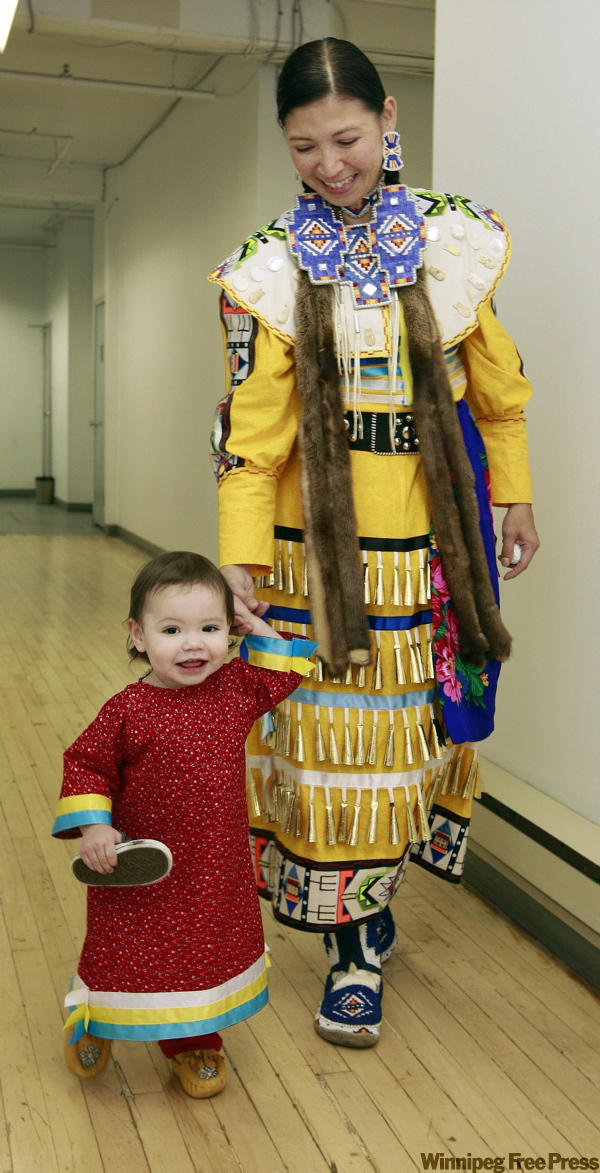Tradition meets innovation at powwow
Hundreds of dancers compete to keep the beat
Advertisement
Read this article for free:
or
Already have an account? Log in here »
To continue reading, please subscribe:
Monthly Digital Subscription
$1 per week for 24 weeks*
- Enjoy unlimited reading on winnipegfreepress.com
- Read the E-Edition, our digital replica newspaper
- Access News Break, our award-winning app
- Play interactive puzzles
*Billed as $4.00 plus GST every four weeks. After 24 weeks, price increases to the regular rate of $19.00 plus GST every four weeks. Offer available to new and qualified returning subscribers only. Cancel any time.
Monthly Digital Subscription
$4.75/week*
- Enjoy unlimited reading on winnipegfreepress.com
- Read the E-Edition, our digital replica newspaper
- Access News Break, our award-winning app
- Play interactive puzzles
*Billed as $19 plus GST every four weeks. Cancel any time.
To continue reading, please subscribe:
Add Free Press access to your Brandon Sun subscription for only an additional
$1 for the first 4 weeks*
*Your next subscription payment will increase by $1.00 and you will be charged $16.99 plus GST for four weeks. After four weeks, your payment will increase to $23.99 plus GST every four weeks.
Read unlimited articles for free today:
or
Already have an account? Log in here »
Hey there, time traveller!
This article was published 07/11/2009 (5820 days ago), so information in it may no longer be current.
There won’t be any broncos at the MTS Centre for this weekend’s Manito Ahbee International Competition Powwow.
But the dancers will be concentrating to make sure they don’t get "bucked off" by drummers and singers who might try to throw them.
Staying on the beat is essential, says accomplished local jingle-dress dancer Joanne Soldier. But dancers never know what song the host drum will play until they hit the floor as a group, each wearing a number so the judges can score them.

Dancers must end the song exactly on the final beat, with both feet on the floor. They have to listen hard, count the recurring heavy "honour beats" that are like choruses, and anticipate the ending.
"There are trick songs," says Soldier, 38. "Some will stop unexpectedly. You have to know the songs. If we overstepped (danced past the end) or stopped too soon, we say we got ‘bucked off.’"
This is a special weekend for Soldier, an Ojibway from Swan Lake who lives in Winnipeg and is an aspiring film producer.
She has travelled the "powwow trail" as a jingle-dress dancer for five years, winning more than $7,000 in prize money. But this is the first time her daughter, 14-month-old Waasayah Munro-Soldier, will participate in the Tiny Tots category.
Wearing a ribbon-trimmed dress, Waasayah will hold her mom’s hand for her dance debut.
"I want her to get to know the culture and be proud of who she is, and our history," says Soldier.
A jingle dress like Soldier’s is decorated with several hundred noisemaking jingles, usually made, even today, from snuff-can lids. The dance traditionally carried spiritual significance.
Today, Soldier says, many jingle dancers are adopting a more flashy contemporary style that includes wearing plumes on the head, carrying a fan and raising it on the honour beats, lifting the knees, crossing the feet and doing other flamboyant footwork.
Out of respect for the old ways, Soldier sticks to the much simpler traditional style. Old-style jingle dancers keep their hands at their waists and their heads bare. They do a lightly bouncing step while showing grace, poise and balance.
Some judges prefer the old style and some the new, says Soldier, who expects at least 30 women in her category. She will pocket $1,200 if she places first.
Since visual presentation is scored, she improves her chances with her impressive regalia, which includes porcupine quillwork, otter tails, elk teeth and shells.
Lisa Meeches, who chairs the Manito Ahbee board and travels the circuit as a fancy-shawl dancer, says powwow dancing is a living tradition that inevitably evolves.
Meeches, 41, says fancy shawl, always the fastest and most showy of the three women’s categories, is becoming more flamboyant, too. It’s always been an intense workout, requiring agility and stamina, but today’s dancers have even been known to incorporate freestyle hip-hop influences.
"How I was raised, the footwork we did was very detailed and intricate," says Meeches. "We didn’t throw our shawls around the way they do now.
"The young girls, they spin, they kick, they’re more aggressive. They’re not as graceful. They don’t have the kind of footwork that us older fancy-shawl dancers use."
alison.mayes@freepress.mb.ca
Jingle all the way
The Manito Ahbee International Competition Powwow, today and Sunday at the MTS Centre, is one of North America’s largest. An estimated 700 dancers, singers and drummers from across the continent are vying in various age and style categories for more than $100,000 in prize money.
This year’s three "host drums" — drum circles and singers who accompany the competition — are from Montana, Oklahoma and Ontario.
A dancer accumulates points through the weekend. Being in one category usually involves dancing three times, for four to 12 minutes each time. Many dancers bring three sets of regalia (outfits).
It’s disrespectful for dancers to miss any of the Grand Entry processions into the arena (Saturday at noon and 7 p.m.; Sunday at noon). It’s also unwise, because they earn points for participating. The way participation is tracked is high-tech: each competitor wears a number carrying a bar code, and gets scanned in.
You don’t have to be aboriginal to enter as a competitor. And each time there’s an inter-tribal dance, it means the whole audience can hit the arena floor.
To learn more about powwow traditions and meaning, anyone with a ticket can attend a presentation called Powwow 101, Saturday at 10 a.m. or Sunday at 10:30 a.m. in the Moose Yearling Foundation Room.

